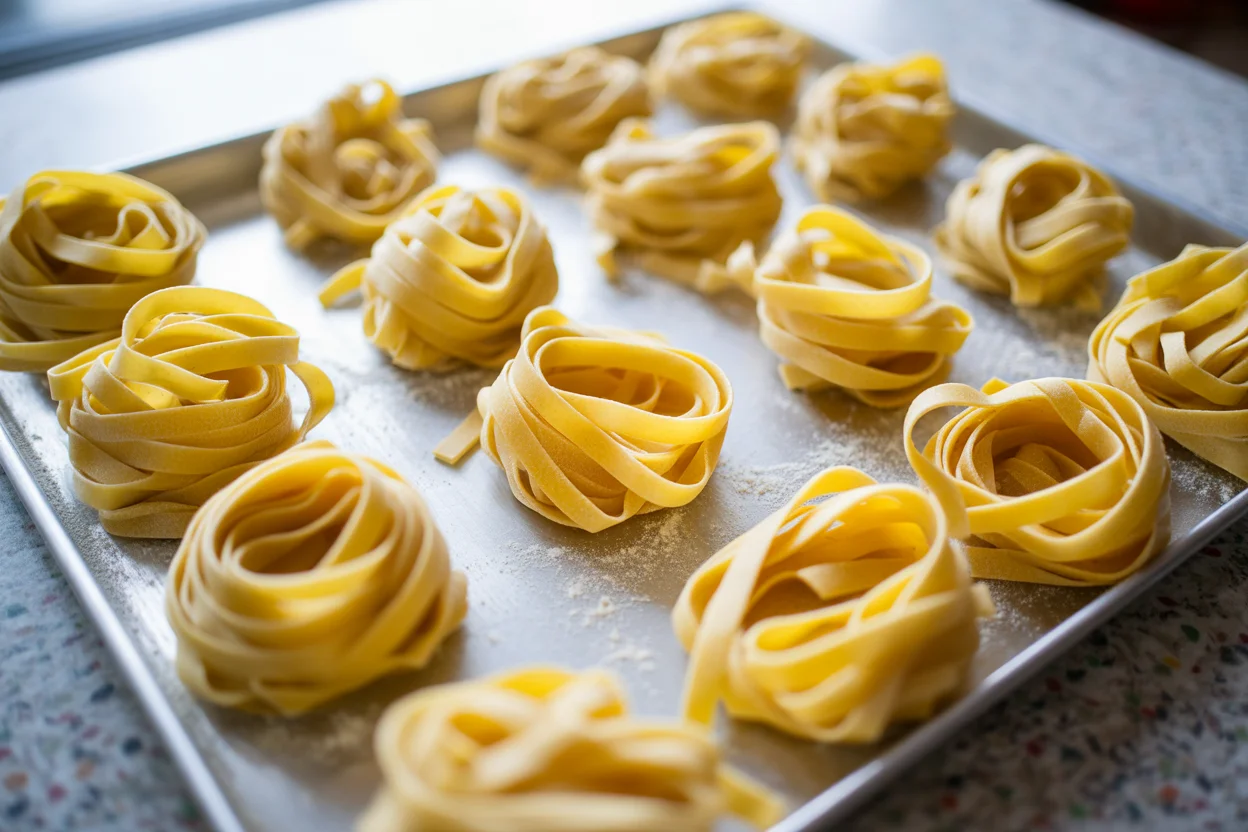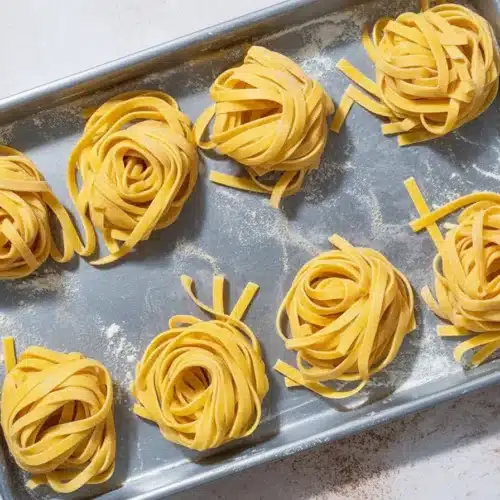- How to Make Pasta
- Homemade Pasta Ingredients
- Equipment for Making Fresh Pasta
- Best Sauce for Homemade Pasta
- Getting Ahead: How to Store Fresh Pasta Dough
- Common Questions
- Give It a Whirl: Homemade Pasta Night Awaits
How To Make Fresh Pasta at home… wow, it sounds intimidating, right? Look, I get it. For years, I thought you needed fancy equipment or some mystical magic to pull it off. But honestly? Once you know the steps, it’s absolutely doable, messy hands and all. Imagine the flavor: chewy, fresh, light noodles—way better than the dry stuff in a box, trust me! Ready to make something that’ll impress everyone, even if you’re kind of a klutz in the kitchen? Let’s dive in.

How to Make Pasta
So, here’s my deal: I used to think making pasta from scratch was, like, a five-star restaurant thing. Turns out, it’s more rustic than “chef-y.” You shove some flour in a pile, make a little well, crack in your eggs, and start mixing. At first, it’ll look like you’ve made a massive mistake (honestly, you’ll wonder if it’ll ever come together).
Keep mixing, smushing, and kneading. Give it 8 to 10 minutes—a workout, I know, but worth it. The dough will get all smooth and elastic. Let it rest, and then it’s ready for rolling. If you don’t have a pasta machine, don’t panic. A regular rolling pin does the job, just roll it thin. Cut into whatever shape grabs you. Fettuccine, tagliatelle, little squares for soup—your choice. The first time you cook it, the kitchen will smell like Italy’s calling your name.
“Honestly, homemade noodles changed pasta night in my house. Kids eat it plain, just olive oil. It’s that good.” Jess, my pasta buddy from back home.
| Item Description Use | ||
| All-purpose Flour | Versatile flour used for most pasta recipes. | Main ingredient for making fresh pasta. |
| Eggs | Gives richness and moisture to pasta. | Essential for kneading the dough and giving flavor. |
| Olive Oil | Adds flavor and helps with dough elasticity. | Optional, for enhanced taste. |
| Salt | Enhances the flavor of the pasta. | Optional, to taste. |
| Pasta Machine | Device for rolling out dough evenly. | Optional, but useful for consistent thickness. |
Homemade Pasta Ingredients
Here’s the shocking secret: you only need two main things: flour and eggs. For real. No mile-long ingredient list, nothing mysterious hiding in your pantry. Typical ratio? About one cup of flour to one large egg. If you want more dough, double or triple as needed.
You can use plain all-purpose flour, or get extra fancy with the “00” stuff (it’s just super fine). Some folks toss in a splash of olive oil or a dash of salt for flavor. Me? I keep it simple. Short shelves, less grocery stress. Oh, and if you’re vegan or out of eggs, you can totally make pasta with just flour and water. It’s a little different, but still tasty.
Equipment for Making Fresh Pasta
Here’s where people get nervous, but—it’s honestly not complicated. The absolute basics? A bowl, a fork (or your fingers), and a flat surface for kneading. That’s it. If you wanna roll like a pro, sure, a pasta machine is fun (and makes even, pretty noodles), but it’s not necessary at all.
I’ve done it on my kitchen counter with a $2 rolling pin from a yard sale. A sharp knife works to cut strips or shapes. If you have a pizza cutter, even better. Drying rack? I just use the back of a chair. No gadgets collecting dust, promise.
Best Sauce for Homemade Pasta
Now, after you’ve learned how to make fresh pasta, you’ll want something seriously awesome to highlight your work. Good news is, fresh noodles don’t need to drown in sauce—they shine best with simple stuff!
My favorites, hands-down:
- Buttery garlic sauce (toss with a little parmesan, wow)
- Herby pesto (basil, pine nuts, olive oil, blended up)
- Classic tomato sauce (homemade or good jarred, simmered with some onion and a pinch of chili flakes)
- Cacio e pepe (cheese plus black pepper, nothing fussy)
Look, your homemade pasta wants just enough sauce to coat it. Don’t go wild here. Let your noodles be the star.
Getting Ahead: How to Store Fresh Pasta Dough
So, let’s say you’re prepping ahead or you made too much (happens to me all the time). The dough itself keeps well. After kneading, wrap it tightly in plastic wrap or drop it in a reusable container. Pop it in the fridge for up to 2 days. Just let it come back to room temp before rolling.
If you’ve already shaped your fresh pasta, spread it out on a floured tray. Let it dry for an hour or freeze it on the tray before tossing into a bag. Straight from the freezer, just cook a minute longer. Never waste a single noodle—use your freezer as a backup plan.
Common Questions
Q: Do I really need a pasta machine?
A: Nope! It helps make even shapes, but plenty of Italian grandmas use rolling pins, and so can you.
Q: My dough’s sticky, what do I do?
A: Sprinkle on a bit more flour and knead. It’ll come together, I swear.
Q: What flour should I use?
A: All-purpose works for most. If you’re feeling extra, go for “00” flour, but don’t stress if you can’t find.
Q: How long should I cook fresh pasta?
A: Only 2 to 3 minutes—seriously! It cooks super fast.
Q: Can I freeze the dough?
A: Yup, wrap it well and freeze. Thaw overnight in the fridge or on the counter for a couple hours.
Give It a Whirl: Homemade Pasta Night Awaits
So that’s my entire process for how to make fresh pasta. It’s simple, affordable, and—dare I say—life-changing for your dinner table. You barely need anything. Thanks for stopping by my kitchen! For more tips, check out this beginner’s pasta making guide by The Kitchn. Trust me, even your pickiest friend will want a second bowl. Now go—make a floury mess, and enjoy every bite.

How to Make Fresh Pasta
Equipment
- Mixing Bowl
- Rolling Pin or Pasta Machine
- Knife or Pizza Cutter
Ingredients
Basic Fresh Pasta Dough
- 2 cups all-purpose flour or ’00’ flour for smoother texture
- 3 large eggs
- 1 tbsp olive oil optional, for elasticity and flavor
- salt optional, a pinch for taste
Instructions
- On a clean surface or in a bowl, make a mound with the flour and create a well in the center. Crack in the eggs.
- Use a fork to gently mix the eggs, slowly incorporating the flour from the edges.
- Knead the dough for 8–10 minutes until smooth and elastic. If sticky, dust with flour.
- Wrap the dough in plastic wrap and let it rest for 30 minutes at room temperature.
- Roll out dough using a pasta machine or rolling pin to desired thinness. Cut into your preferred shape (fettuccine, tagliatelle, squares).
- Boil in salted water for 2–3 minutes or until tender. Toss with sauce and serve immediately.

